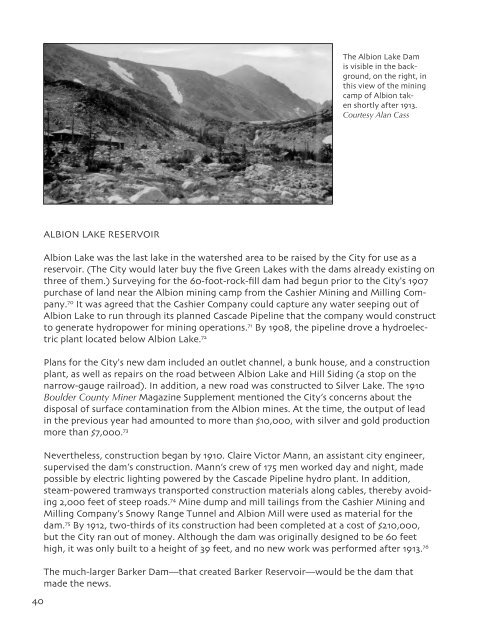Create successful ePaper yourself
Turn your PDF publications into a flip-book with our unique Google optimized e-Paper software.
The Albion Lake Dam<br />
is visible in the background,<br />
on the right, in<br />
this view of the mining<br />
camp of Albion taken<br />
shortly after 1913.<br />
Courtesy Alan Cass<br />
40<br />
ALBION LAKE RESERVOIR<br />
Albion Lake was the last lake in the watershed area to be raised by the City for use as a<br />
reservoir. (The City would later buy the five Green Lakes with the dams already existing on<br />
three of them.) Surveying for the 60-foot-rock-fill dam had begun prior to the City's 1907<br />
purchase of land near the Albion mining camp from the Cashier Mining and Milling Company.<br />
70 It was agreed that the Cashier Company could capture any water seeping out of<br />
Albion Lake to run through its planned Cascade Pipeline that the company would construct<br />
to generate hydropower for mining operations. 71 By 1908, the pipeline drove a hydroelectric<br />
plant located below Albion Lake. 72<br />
Plans for the City's new dam included an outlet channel, a bunk house, and a construction<br />
plant, as well as repairs on the road between Albion Lake and Hill Siding (a stop on the<br />
narrow-gauge railroad). In addition, a new road was constructed to Silver Lake. The 1910<br />
Boulder County Miner Magazine Supplement mentioned the City’s concerns about the<br />
disposal of surface contamination from the Albion mines. At the time, the output of lead<br />
in the previous year had amounted to more than $10,000, with silver and gold production<br />
more than $7,000. 73<br />
Nevertheless, construction began by 1910. Claire Victor Mann, an assistant city engineer,<br />
supervised the dam’s construction. Mann’s crew of 175 men worked day and night, made<br />
possible by electric lighting powered by the Cascade Pipeline hydro plant. In addition,<br />
steam-powered tramways transported construction materials along cables, thereby avoiding<br />
2,000 feet of steep roads. 74 Mine dump and mill tailings from the Cashier Mining and<br />
Milling Company’s Snowy Range Tunnel and Albion Mill were used as material for the<br />
dam. 75 By 1912, two-thirds of its construction had been completed at a cost of $210,000,<br />
but the City ran out of money. Although the dam was originally designed to be 60 feet<br />
high, it was only built to a height of 39 feet, and no new work was performed after 1913. 76<br />
The much-larger Barker Dam––that created Barker Reservoir––would be the dam that<br />
made the news.



